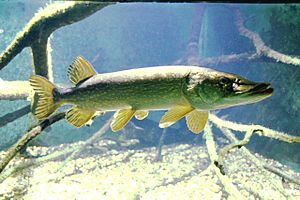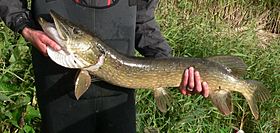Esox facts for kids
Quick facts for kids Esox |
|
|---|---|
 |
|
| Northern pike (E. lucius) | |
| Scientific classification | |
| Kingdom: | |
| Phylum: | |
| Class: | |
| Superorder: | |
| Order: | |
| Family: |
Esocidae
G. Cuvier, 1817
|
| Genus: |
Esox
Linnaeus, 1758
|
| Type species | |
| Esox lucius Linnaeus, 1758
|
|
Esox is a genus of fresh water fish. It is the only living genus in the family Esocidae. The oldest known example of Esox is the fossil Esox tiemani. It dates to about 62 million years ago and was found in Alberta, Canada. Esox are commonly called pike and pickerel. They are found in the northern parts of North America, Europe and Asia. One species, Esox lucius, the Northern pike, is found in both Europe and North America. Esox are large predatory fish with a long cylindrical body. They have a green color (various shades) with yellow eyes. Pike and pickerel share a forked tail fin and a large pointed head. Their dorsal and anal fins are located far back on their bodies. All species have very sharp teeth.
Species
Currently there are five species in the Esox family. The study of this family is not complete. There are several known hybrids between species which occur naturally. The five species are:
- Esox lucius - The Northern Pike; found in both Eurasia and North America.
- Esox reichertii - The Amur pike; found in the Amur river in Asia.
- Esox masquinongy - The Muskellunge; found in northern and eastern North America.
- Esox niger - The Chain pickerel; native to the U.S. states of Georgia and North Carolina.
- Esox americanus - The redfin pickerel; also found in Georgia and North Carolina.
Diet

Pike feed on a wide range of food sources, predominantly smaller shoal fish. Pike are also cannibalistic, sometimes preying upon smaller members of their own species. This can be seen clearly in the northern pike.
They will also prey on insects and amphibians such as newts or frogs in times when their usual food is scarce, and occasionally on small mammals like moles or mice when caught water-borne. Small birds such as ducklings may become a target for hungry pike. Pike are also known to prey on swimming snakes.
They are, however, undeserving of their reputation for being overly vicious predators. There are few substantiated incidents of pike "attacks" on people. Pike's further reputation as a pest seems to lie predominantly amongst a small handful of anglers and fishery managers who think, perhaps unfairly, that pike are a threat to native rough fish and also other sport fish.
Angling
Effective methods for catching this hard-fighting fish include dead baits, live baits, and lure fishing. Pike can easily be damaged when handled since they are not as robust as their reputation would suggest. Colour of lure can be influenced by water clarity and weather conditions. Since pike have numerous sharp teeth it is wise to take extreme care when unhooking them. The use of a wet leather gauntlet and surgical forceps to remove hooks is highly recommended on safety grounds. If practicing catch and release fishing, care for the pike should be the pike angler's utmost concern. The formerly recommended practice of grasping a pike by its eye sockets (tragically interpreted as "its eyes") resulted in countless released pike that quickly died from inability to see prey any longer.
The current recommended method of grasping pike is to close the hand firmly over the gill covers, and to make the period of handling as short as possible before release. Grabbing a pike by the gill covers is not feasible when a pike is very big, but it is easy to handle a pike by inserting the fingers at the bottom of the gill opening and grabbing the lower jaw. Big pike should also be supported at the belly. When a pike is held this way it is also easier to keep the mouth open to remove a hook. Some anglers now use special grips to grab the pike's front lower jaw, which can add to the safety of an anglers because of the danger imposed by the hooks of the lure or tackle and the pike's teeth. However these can cause serious damage to a pike's lower jaw. The Pike Anglers Club was formed in 1977 to campaign for the preservation of pike and the sport of pike fishing.
A practice known as gut hooking was previously widely used in catching pike. Upon taking the bait, the pike will hold it for a short time in its mouth as it moves off. The pike will then, usually, turn the bait in its mouth, so that it sits in alignment with its throat to ease swallowing. It is recommended that when pike fishing the process is not allowed to go this far and a strike is recommended as soon as a bite is indicated. Otherwise, what is known as gut hooking will result, which will normally kill or seriously injure the fish. Dutch research shows that cutting the line immediately when the fish is gut hooked will still give low mortality (14%). The hooks in the gut or stomach were either encapsulated or removed from the body. Placing hooks near the rear of the bait reduces the risk of deep hooking.
Other methods of catching and handing pike that are now frowned upon are the gaff and the gag. The gaff is a metal hook on the end of a pole used to hook through the fish's body in place of a more humane landing net. A gag is a device for holding open the pike's mouth whilst unhooking. These are now illegal in Scotland, as they put a huge amount of pressure on a pike's jaw, thus causing irreparable damage.
In mythology
Russian mythology holds that the pike is one of several forms assumed by evil water spirits called vodyanoy, and a ravenous mythical pike is traditionally blamed for decimating the fish population in the Sheksna River. Russian fairy tales, on the other hand, also tell about an old wise pike that can fulfil wishes of the one who catches it, if its catcher releases it back into its habitat.
In the Finnish Kalevala, Väinämöinen creates a kantele (string instrument) from the jawbone of the pike.
Submarines and tanks
Two United States Navy submarines have been named Pike – SS-6 of 1903 and SS-173 of 1935 – and three – SS-22 of 1912, SS-177 of 1936, and SS-524 of 1944 – named Pickerel. In addition, the Soviet submarines known to NATO as the Victor III class and Akula class are called the Shchuka (Щука, "pike") class in Russian. The Soviet Iosif Stalin tank (IS-3) was also nicknamed Shchuka, in reference to its sharply pointed hull front.
Heraldry
In heraldry, the pike is called a lucy (English heraldry) or a ged (Scottish heraldry). It is usually blazoned either naiant (swimming), embowed (bowed) or hauriant (jumping), though pairs of lucies may appear addorsed (back to back), as in the arms of the Finnish town of Uusikaupunki (Argent, two lucies addorsed azure).
Images for kids
-
A young E. lucius specimen — a "chain pickerel" in the original sense — in an aquarium.
-
Quenelle de brochet sauce Nantua
See also
 In Spanish: Lucios para niños
In Spanish: Lucios para niños









